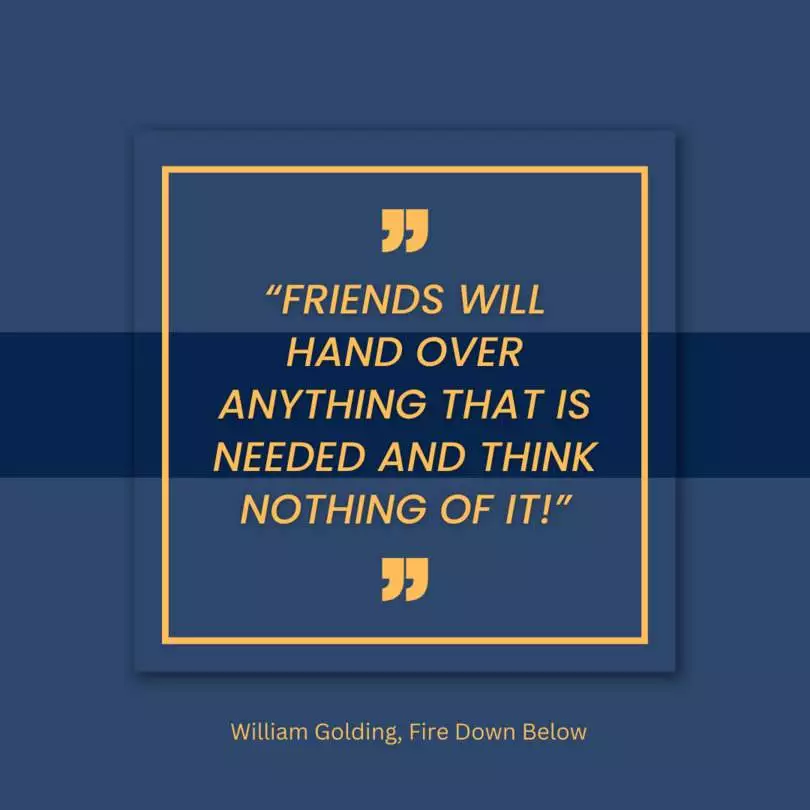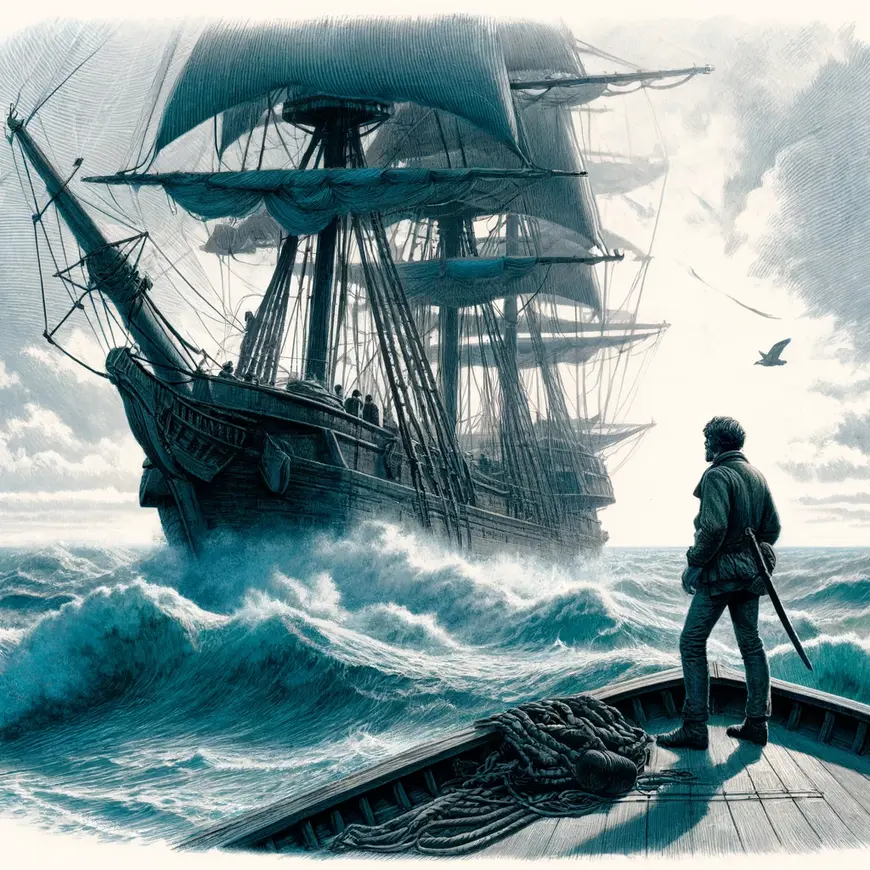into the Depths of Humanity: “Fire Down Below” by William Golding
A quick summary of my thoughts on Golding’s Fire Down Below
Reading “Fire Down Below” by William Golding was a experience. The vivid descriptions and tense atmosphere of the novel immediately drew me in. The story of a sea voyage, during the century felt incredibly realistic and engaging.
On a level I could sense the fear and uncertainty that the characters experienced as they navigated the perils of the sea. The confined space on the ship and the present threat of disaster kept me constantly on edge. Goldings portrayal of the crews struggles and their fight for survival was both thrilling and deeply unsettling.
From a standpoint this book prompted me to contemplate resilience. The themes of leadership, loyalty and human nature explored in the novel were thought provoking. Goldings intricate depiction of life aboard the ship with its obstacles and adversities provided me with an insight into the backdrop and complexities of human existence.
There are only few authors who possess the uncanny ability to navigate the treacherous depths of the human soul with such precision and unforgiving clarity as William Golding. With his haunting novel “Fire Down Below,” Golding delves into the darkest recesses of human nature, exposing the smoldering embers of primal desires and the harrowing consequences of unchecked power.
Set in a remote Caribbean island, “Fire Down Below” serves as a haunting continuation of the moral exploration Golding began in his acclaimed novel “Lord of the Flies.” The story unfolds in the aftermath of a volcanic eruption that engulfs the island in a cloak of devastation and chaos. As the survivors grapple with the physical and psychological aftermath of the catastrophe, Golding casts a searing spotlight on the battle for dominance, the erosion of morality, and the primordial instincts that lie dormant within each human being.

Crafting complex and multi-dimensional characters
One of the most striking elements of “Fire Down Below” is Golding’s skill in crafting complex characters. Hugh, the enigmatic protagonist, is a conflicted scientist. He is burdened with guilt and inner turmoil. Stowey, a malevolent figure, is a self-appointed leader. He is driven by an insatiable hunger for control. Each character explores human depravity and the frailty of the human psyche.
Golding’s prose burns with intense power. His vivid descriptions of the volcanic landscape mesmerize and discomfort. The tumultuous emotions of the characters create a palpable atmosphere. Readers are engulfed in fear, desire, and moral decay. The raw power of his language mirrors the destructive forces within the characters. This leaves an indelible mark on the reader’s mind.
At the heart of “Fire Down Below” lies a profound exploration of human darkness. Golding peels back societal layers, revealing savagery and animalistic instincts. The survivors grapple with their new reality. The novel becomes a microcosm of civilization on the brink of collapse. It reflects the human capacity for violence and the fragility of social order.
Masterful Storytelling
Through his masterful storytelling, Golding raises thought-provoking questions about power and authority. He shows how power dynamics can corrupt. Stowey, with his manipulative tactics and thirst for dominance, is a cautionary tale. He symbolizes the darkness that can consume ordinary people. Golding explores the dance between power and morality. He reveals the human tendency to exploit and oppress. This sheds light on the fragile balance between civilization and chaos.
Timeless Themes of guilt, redemption, and the quest for meaning
Furthermore, “Fire Down Below” delves into timeless themes of guilt, redemption, and the quest for meaning. Hugh, burdened with remorse, embarks on self-discovery. He grapples with his inner demons. Golding portrays Hugh’s internal struggle as both poignant and harrowing. Hugh confronts the consequences of his choices. He seeks redemption amid the wreckage of the island and his fractured psyche.
In true Golding fashion, “Fire Down Below” is an allegorical masterpiece. The volcanic eruption symbolizes human nature’s destructive power. The island, once a paradise, becomes a purgatorial landscape. Characters confront their moral failings. They face the consequences of their actions. The story serves as a haunting reminder of civilization’s fragility. It shows the dire consequences of succumbing to our darkest impulses.
Famous Quotes from “Fire Down Below” by William Golding
- Quote: “The sea does not permit any falsehoods or pretences; it is the honest face of nature herself.”
- Explanation: This quote speaks to the theme of nature as a force of truth and authenticity. Golding often contrasts the artificiality and moral corruption of society with the honesty and brutality of the natural world.
- Quote: “We are all of us a ship upon the sea of time, and we must make our passage as best we can.”
- Explanation: Here, Golding uses the metaphor of a ship’s journey to reflect on the human condition and the passage of life. The novel itself, detailing a voyage from England to Australia in the early 19th century, serves as an allegory for life’s journey, with all its trials, tribulations, and moments of beauty. This quote underscores the inevitability of time’s passage and the individual’s struggle to navigate through it.
- Quote: “In every man, there is the potential for a storm, and we must be ready when it comes.”
- Explanation: Golding often explores the darker aspects of human nature, suggesting that beneath the veneer of civilization lies a tumultuous and potentially destructive force. This quote reflects his belief in the inherent capacity for violence and chaos within individuals, a theme that resonates throughout his body of work, most notably in “Lord of the Flies.”

Trivia Facts about “Fire Down Below”
- Part of a Trilogy: “Fire Down Below” (1989) is the conclusion of William Golding’s Sea Trilogy, following “Rites of Passage” (1980) and “Close Quarters” (1987). The trilogy chronicles the journey of Edmund Talbot aboard a British naval ship bound for Australia in the early 19th century, with each book focusing on different segments of the journey.
- Rites of Passage Won the Booker Prize: The first book in the trilogy, “Rites of Passage,” won the Booker Prize in 1980. This accolade significantly heightened interest in Golding’s work beyond his most famous novel, “Lord of the Flies,” and set high expectations for the subsequent novels in the trilogy.
- Autobiographical Elements: While not directly autobiographical, Golding’s experience in the Royal Navy during World War II informed his vivid descriptions of life at sea and the psychological depth of his characters.
- Exploration of Social Hierarchy: The trilogy delves into the British class system and social hierarchy of the early 19th century. Golding examines the tensions, alliances, and social maneuvering that occur within this confined setting.
- Adapted into a Television Series: The entire trilogy was adapted into a television miniseries titled “To the Ends of the Earth,” broadcast in 2005. This adaptation brought Golding’s sea voyage narrative to a wider audience, though, as with most adaptations, there were differences from the source material.
- Legacy: While “Fire Down Below” and the Sea Trilogy as a whole may not have achieved the same level of fame as “Lord of the Flies,” they remain an important part of Golding’s oeuvre, showcasing his breadth as a writer and his ability to explore complex themes through diverse settings and narratives.
Conclusion Fire Down Below
In conclusion, “Fire Down Below” is a searing inferno of a novel. It scorches the reader’s mind with its unflinching portrayal of the human condition. William Golding’s masterful prose, complex characters, and thematic depth ignite a fire within the reader. He compels us to confront uncomfortable truths buried within our own souls. Prepare to be consumed by the flames of this harrowing journey. In this abyss, boundaries between light and darkness blur. The embers of humanity’s darkest secrets burn bright.
More Reviews of Works by Golding
Unfolding Complexity: A Deep Dive into William Golding’s The Paper Men My Summary on The Paper Men by William GoldingReading…
William Golding’s Towering Tale of Ambition and Descent – Unraveling “The Spire” William Golding, acclaimed for his classic “Lord of…
the Myths of “The Scorpion God” – William Golding’s Exploration of Ancient Tales “The Scorpion God” by the British author…
the Dark Heart of Humanity: William Golding’s “The Lord of the Flies” – the Fragility of Civilization My Summary on…



